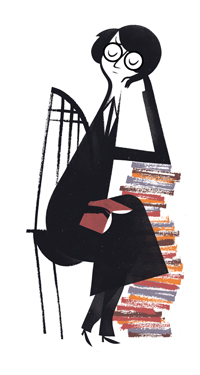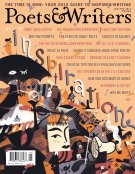San Francisco–based artist Roman Muradov is the sixth artist we’ve asked to create an original cover for our annual Inspiration Issue—a tradition that started in 2010 when veteran designer Chip Kidd returned from a trip to Istanbul with a set of Spirographs that inspired his work on our January/February 2010 issue. Muradov, a prolific illustrator who has worked for publications such as the New Yorker, Vogue, and Time, as well as for Penguin Random House, Houghton Mifflin Harcourt, and Knopf, is the author of the graphic novel (In a Sense) Lost & Found, published in September 2014 by Nobrow Press. He recently spoke about the endlessly fascinating illustration on our cover, and about his artistic process.
 How would you describe your work?
How would you describe your work?
My work is a lifelong celebration of futility. I see everything I make as a process of simultaneous deciphering and encryption heavily layered and divorced from the search for artistic truth of any kind. My characters are always in the middle of writing or reading or making something, but there’s never a beginning or an end to their endeavors. The function of the visual side is partly to seduce the reader into looking at the piece and partly to interpret the theory behind it all.
How did you arrive at your style of illustration?
People tell me I have a recognizable style, but I myself try to change it all the time, chiefly out of boredom. As soon as I’m confident with a medium, I pick a different approach to make myself feel uncomfortable again. Ideally I strive to do with images what James Joyce did with words, and the futility of that aspiration justifies it even further.
I love that description of your style, because it matches my experience of looking at the cover illustration you created for us. Part of what makes it so fascinating is that one can’t quite tell where one element begins and another ends. Can you talk a bit about the process through which you are able to create this effect?
I struggle with the concept of inspiration a great deal myself, and I like the OuLiPian idea of escape from inspiration through self-imposed constraints. In that sense, I approach pieces like the cover with a mix of accident and design, structuring everything tightly in a sketch, then allowing chance variations on paper, and finally editing the whole thing in an attempt to preserve both the structure and the spontaneity.
I also like novelist Tom McCarthy’s description of his process as “plugging literature into other literature,” and I was going for something along these lines—an endless procession of styles and information layering upon each other. Drawing each element separately with ink washes—such a natural medium—works well because it allows for shapes to overlap subtly and have planned and unexpected interactions.
How important to your work is the written word—the text underneath the cover of the magazine or the book to which you are lending your art?
More important than anything. I see my work as writing in pictures, so I spend much more time on research, reading, and rereading, than is usually required, particularly with book covers and fiction.
Where do you turn when the well is running dry?
To me, drawing or writing is just a by-product of being an artist. I think passive time is of much greater value than active time, so I dedicate hours and days to walking around aimlessly, reading, or doing nothing. Marcel Duchamp understood this better than anyone, and I think idleness is a form of art, one that should be praised, contemplated, and exercised daily.
In short, my answer is: “Doing nothing. A lot.”
Kevin Larimer is the editor in chief of Poets & Writers, Inc.









Comments
Janelle Fila replied on Permalink
I love the idea that
I love the idea that characters are always in the middle of reading, writing, or making something, yet there is never a beginning or an end. That sounds like an artists' life, doesn't it? At least, I hope so. Because I don't really ever remember beginning or choosing to begin, I just remember loving to read and write, creating and living in fantastical worlds with great friends and terrible enemies. And I hope I never stop. I hope I am still creating no matter how old I become and that I am still contributing to the world with some form of beautiful, inspiring art. Janelle www.janellefila.com